
In her first year as Square Root’s VP of product, Sarah Kampman has accomplished more than some C-level executives check off during their entire stint at a company.
Kampman has led a complete transformation across Square Root’s engineering and product teams in how they approach their work and engage with users — directly impacting company culture as a result. Under her direction, the company and product has undergone an evolution that Kampman sums up in just one word: “unity.”
We connected with Kampman to learn more about her work at the company behind CoEFFICIENT, a software solution that surfaces meaningful insights paired with the right actions for brands to execute.
First, what attracted you to Square Root when you accepted your position last year?
I love that Square Root is a company in transition. It’s more fun for me to help blaze a product trail instead of following a path that’s already decided. Extending from auto to retail industries is appealing, and this provides opportunities to learn a new market, experiment with messaging, understand use cases and accelerate development to be the first to tackle these challenges.
How has Square Root’s product shifted over the past year?
If there’s one word to describe the evolution of the product and product team in the past year, it’s “unity.” We’re orienting our product around the users and their needs, which leads to reconciling modules, streamlining the UI and targeting new features that pull together information into a single source of truth and action.
This year’s goal is customer empathy.”
How has the company changed the way it interacts with its users to support that shift?
We’ve spent a lot of time listening to our end users, stakeholders and the market at large. We ask questions about their problems and goals, go on “ride alongs” to experience their days firsthand and run rapid prototypes to gather specific feedback.
We use yearly goals to orient everyone to an important tactic or priority. This year’s goal is customer empathy: we encourage every single Radical, the math-inspired name we give our team members, to listen to at least 12 customer calls and 12 sales calls. This gives everyone firsthand experience with our customers and prospects and provides our team with insights into what matters to the user. Those insights continuously make their way into sprint planning, collateral and everything in between.
How has the engineering team adjusted to support those changes?
Just like the product is unifying, the engineering team has come together, too. We’ve broken down silos, which has made a huge difference to velocity. Isolated groups can’t focus on a single goal as well as a unified team. Cross-functional teams don’t suffer from communication delays or post-handoff surprises. It also just feels good to be working together toward a common purpose.
How does your team approach technical challenges?
We give our teams autonomy when tackling new technical tasks. After identifying a challenge, the team as a whole will prioritize it in the workflow and empower one Radical to investigate. The individual owns the exploration and proceeds with research, internal or external resource consultation, or hands-on experimentation. They come up with a proposal at the end of the sprint to share with the team, in the form of a problem-solving approach or a recommendation for further research. When it’s time to implement the change, the same Radical often leads the team in tackling it.
What are you most proud of your team for?
The personal level of care for both our customers and each other. The customer empathy goal didn’t come out of nowhere; we just formalized it to ensure we spent intentional time listening and deciding how to support their needs. My colleagues here also attend to their coworkers’ needs with the same care. We celebrate small victories together, and we take time to listen quietly when something is going wrong.
And the food that’s brought in is always carefully labeled for everyone’s allergies and preferences. That may seem tiny, but it shows that even in the little interactions, we care enough about the individuals around us to make the effort.







